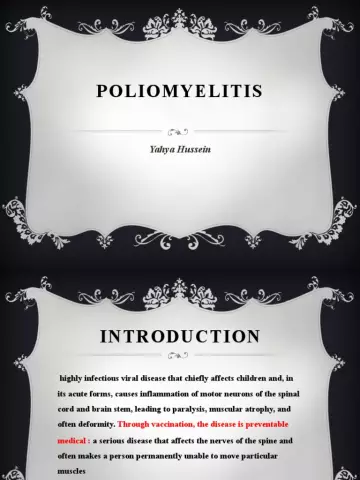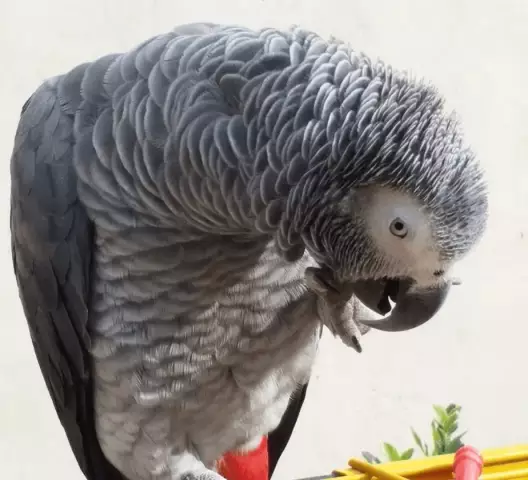- Author Rachel Wainwright [email protected].
- Public 2023-12-15 07:39.
- Last modified 2025-11-02 20:14.
Polio

Literally translated, the name of the disease "Poliomyelitis" sounds like "gray spinal cord", that is, in this infectious disease, the pathogen, which is an enterovirus, first of all penetrates into the gray matter of the spinal cord and the motor nuclei of the brain stem.
Poliomyelitis is also called Heine-Medin disease, infantile spinal palsy, acute epidemic poliomyelitis, spinal infantile paralysis, and epidemic infantile paralysis. As the names suggest, children under the age of seven are at risk. A disease transferred at a young age can significantly reduce the quality of life in the future, since one of the most severe complications of poliomyelitis is damage to the central nervous system, characterized by the development of flaccid paresis and paralysis.
In some cases, the disease proceeds in an erased or asymptomatic form. A person can be a carrier of the virus, releasing it into the external environment along with feces and nasal secretions, and at the same time feel completely healthy. Meanwhile, the susceptibility to poliomyelitis is quite high, which is fraught with a rapid spread of the disease among the child population.
Although poliomyelitis is believed to be a disease of people living in unsanitary conditions, it is not uncommon for an epidemic to occur, regardless of hygiene conditions, in places where the population is not immune to this serious disease. The seasonality of the occurrence of poliomyelitis is noted, the peak of the incidence occurs in the summer-autumn period.
Types and symptoms of poliomyelitis
On average, it takes 7-12 days from the onset of infection to the onset of symptoms. The virus enters the human body through the alimentary (food) route through contaminated food and water. Initially, it is colonized in the gastrointestinal tract and only then is absorbed into the blood. Poliomyelitis can be mild or severe.
Depending on the localization of the process and the possibility of the development of paralysis, poliomyelitis is divided into two forms, which in turn are divided into several more types:
a) Non-paralytic poliomyelitis. This form is found in most cases.
- abortive, when the disease proceeds as an acute respiratory illness or flu. The patient complains of deterioration of health, weakness, fatigue, headache and fever. Sometimes there is a slight dysfunction of the intestine, hyperemia of the throat, catarrhal phenomena from the upper respiratory tract. Recovery occurs in 3-5 days.
- meningeal. The virus infects the serous membranes of the brain, so poliomyelitis occurs as serous meningitis. The most typical complaints for this form of the disease are fever, vomiting, sharp head and leg pains. True meningeal symptoms, such as a stiff neck, are mild. The disease disappears almost without a trace 3-4 weeks after the onset.
b) Paralytic poliomyelitis. It develops quite rarely, but, as a rule, leads to disruption of many body functions and, accordingly, to disability:
- spinal. Weakness and pain in the muscles are gradually replaced by paralysis, both general and partial. Muscle damage in this form of poliomyelitis can be symmetrical, but paralysis of individual muscle groups occurs throughout the body.
- bulbar. The danger of this type of poliomyelitis lies in the development of respiratory paralysis, in severe cases leading to the death of the patient.
- pontine. This type of poliomyelitis is characterized by the development of paresis and paralysis of the facial nerve, in which there is a partial or complete loss of facial movements.
- mixed, which is characterized by a combination of symptoms of all types of paralytic poliomyelitis.
Polio treatment
Until now, there is no specific treatment for polio. The fight against the disease consists in carrying out symptomatic therapy in a hospital setting. To prevent the development of osteoarticular complications in the preparalytic and paralytic stages, the patient is shown absolute rest. Also at this time, anti-inflammatory and analgesic drugs, vitamins, tranquilizers are used. With paralysis of the respiratory system, a ventilator is connected.
During the recovery period, in addition to drug therapy, physiotherapy, massage and physiotherapy exercises are used. In addition, treatment with an orthopedist is recommended. In the future, a patient who has undergone poliomyelitis is shown regular spa treatment.
Prevention of poliomyelitis

The best prevention of the onset of polio and the complications after it is vaccination, after which a lifelong resistance to the three main viruses that cause the disease is created.
Vaccinations against poliomyelitis begin at the age of three months. Oral and inactivated vaccines are used. In the first case, the introduction is carried out through the mouth, in the second - by injection.
In the period up to six months, the baby receives a total of three doses of the specific vaccine. To maintain an acceptable level of immune status, revaccination is performed. The timing of the reintroduction of the vaccine depends on its form: the oral vaccine is given at the age of 18 and 20 months, then at 14 years, while the revaccination of the inactivated polio vaccine is carried out one year after the completed vaccination and then every five to ten years.
Simultaneous administration of the DPT vaccine and poliomyelitis into the body is allowed, but with different syringes and in different places.
In general, the polio vaccine is well tolerated, only in some cases there is pain at the injection site, slight hyperemia, low body temperature and a slight induration. Giving the oral vaccine may cause abdominal pain, loose stools, and general malaise. All these phenomena disappear very quickly and without a trace, they do not require special treatment.
It is undesirable to refuse vaccinations against poliomyelitis, arguing that after vaccination, complications and infection are possible. It should be remembered that even if a child gets sick, then vaccinated in accordance with the vaccination schedule will be much easier to transfer the disease, without the development of such a serious complication of poliomyelitis as paralysis.
YouTube video related to the article:
The information is generalized and provided for informational purposes only. At the first sign of illness, see your doctor. Self-medication is hazardous to health!






